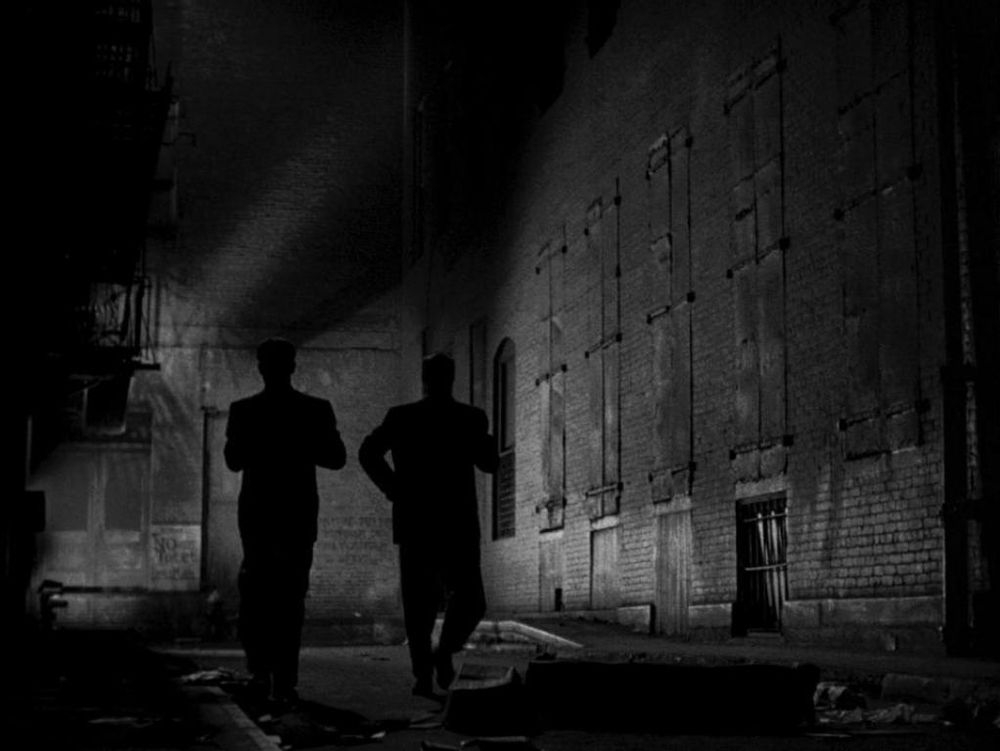
Killer's Kiss is a 1955 Film Noir starring Jamie Smith and Irene Kane.
Davey Gordon (Smith) is a washed-up welterweight boxer in New York City. His apartment is across an alleyway from that of Gloria Price (Kane), a taxi dancer. One evening Davey's attention is drawn by screams from Gloria's apartment, where she is being roughed up by her boss, Vincent Rapallo. Davey chases Vincent out of Gloria's apartment. Soon enough, they fall in love and decide to go away together—but Vincent isn't willing to let Gloria get away so easily.
Killer's Kiss was directed by a 27-year-old magazine photographer named Stanley Kubrick. It was his second feature, financed by $40,000 in loans from family and friends. While the acting is sometimes wooden and the dialogue awkward, Kubrick's sophistication in framing visuals is already in evidence. While his first film, Fear and Desire, was barely released, Killer's Kiss was picked up by United Artists for $100,000 and given wide release. It helped Kubrick get recognition in Hollywood as an up-and-coming young genius.
Tropes:
- Alliterative Title
- Beauty Is Never Tarnished: Davey takes a beating, getting knocked down three times in his fight. When he's shown back at his apartment, there isn't a mark on his face.
- Between My Legs: Davey's opponent is framed between Davey's legs as they sit on their stools before the fight. Davey promptly gets knocked out.
- Big Applesauce: Shot around New York. Most notable for the scenes shot in the beautiful old Penn Station, which was demolished a decade later.
- The Cameo: Ruth Sobotka, Kubrick's second wife, plays Gloria's sister Iris in the ballerina scene.
- Camera Abuse: This effect is simulated when Vincent flings a glass at the camera in a fit of rage.
- Chiaroscuro: Kubrick obviously picked up quite a bit from Film Noir. Nearly every indoor scene in the movie, as well as the night scenes, are shot in the shadows with dramatic contrast between light and darkness.
- Creepy Doll: Or a creepy mannequin. Davey and Vincent have their climactic fight in a mannequin warehouse. It is very creepy.
- Death by Childbirth: Happens to Gloria's and Iris's mother during Gloria's birth.
- Dream Sequence: Davey has a dream symbolized by a shot of an NYC street in photographic negative.
- The Film of the Book: Averted, and notable because this film was the last time Stanley Kubrick made a movie off an original story. Every film he made for the rest of his career was based off a pre-existing novel or short story.
- Flashback: Most of the movie is made up of flashbacks, and there is a flashback within a flashback when Gloria tells her family history.
- Hitler Cam: Used for the boxers during Davey's fight.
- Hong Kong Dub: After having difficulty with the boom mike casting shadows in his shots, Kubrick elected to dub in all the dialogue after-the-fact. In certain scenes it doesn't match up very well.
- How We Got Here: The film opens with Davey at the train station, waiting for his train out of town. He then narrates the whole story in flashback.
- Interplay of Sex and Violence: Vincent gets turned on by watching the TV broadcast of Davey's fight, and starts pawing at Gloria.
- P.O.V. Cam: Used from Davey's POV when he is knocked out, complete with a shaking ceiling light as Davey stares up from the canvas.
- Same Language Dub: Irene Kane was unavailable when it was time to dub the dialogue, so all of her dialogue was dubbed by a different actress.
- Shout-Out: In one scene, Davey is studying his face in a mirror before heading into the boxing ring. This is a nod to a similar scene in Stanley Kubrick's first film as a director, Day of the Fight, a documentary short following the routine of a boxer as he prepares to head into the ring.
- Soft Glass: Davey is unscathed after jumping through a window.
- Surprisingly Happy Ending: Both characters survived and they meet at the railway station to be together. In an example of
 Executive Meddling, this happy ending was not in Kubrick's plan. Against Kubrick's wishes, United Artists required him to reshoot a happy ending because they were displeased with the original dour one.
Executive Meddling, this happy ending was not in Kubrick's plan. Against Kubrick's wishes, United Artists required him to reshoot a happy ending because they were displeased with the original dour one.
